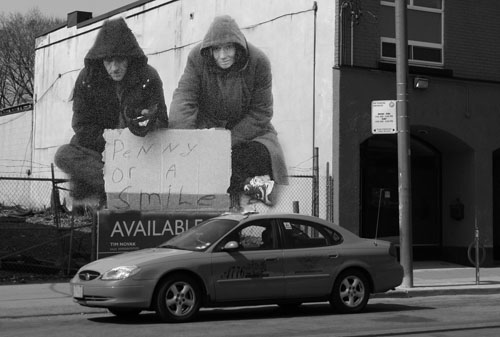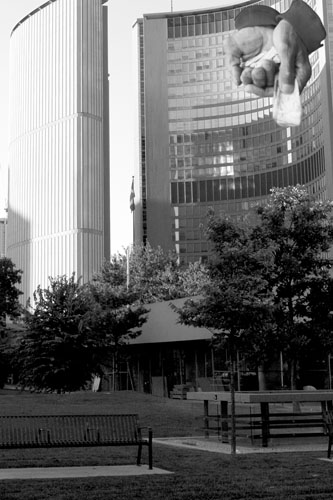Reconstruction 7.1 (2007)
Return to Contents, Capital, The state»
Realistic Possibilities of Passing Interest/ Nancy Viva Davis Halifax and Fred Yurichuk
Abstract:This reflection on a series of photographs from the exhibition URGENT gathered by members from "A day in the life photography and story collective" begins to examine the way social structures are implicated in the lives of those who are living in poverty and how their lives can be rendered visible. Through our work in communities with people who are experiencing homelessness and insecure housing we consider the role of photography in picturing and subjecting communities to a gaze that has the potential to be empathic and engaged or uncaring and disengaged.
... our ability to survey human pain around the world does not offer any guarantee that we will be able to better prevent such suffering. But this increasing vision does not produce a tyranny of non-action either. What the circulation of images of suffering does is offer a lens by which one might think through the problem of responsibility to others and the world. (Sliwiniski 160)
<1> The photographic work that is being presented here is from an exhibition that will be shown in 2007. It is excerpted from a series of proposed projections for the City of Toronto. The prints do not encompass the lasting archival quality that photographic fine art prints have. These prints reflect the transient nature of the lives of the artists that make them and the material - canvas - echoes the body of the tents and the tent cities that have appeared and disappeared across urban and rural landscapes.
<2> ![]() denotes a state requiring immediate attention. Used on a package it will guarantee its delivery.
denotes a state requiring immediate attention. Used on a package it will guarantee its delivery. ![]() is a bodily state of anxiety and tension. It is a word that fills me with a hushed despair and a word that as I write slips into the grave. Written, it slips into its opposite state - inconsequential, trivial, of passing interest.
is a bodily state of anxiety and tension. It is a word that fills me with a hushed despair and a word that as I write slips into the grave. Written, it slips into its opposite state - inconsequential, trivial, of passing interest.
<3> In this work we have been preoccupied with the absence and presence of particular kinds of bodies in systems of representation and how the lack of these bodies influences systems of discourse. When people pass by bodies lying on streets, they do not stop to see if they are breathing - we discern a memory that establishes our strangeness with one another, a wide-awake state pricked by restless disquiet. Photographs of bodies asleep, and the spaces and places that sleeping bodies have inhabited, do not provide the sense of urgency felt when confronted with structural violence. We feel it is implicitly sensed in our photographic montages.
the homeless and the insecurely housed
are now appearing in documents coded with the language of corporate
strategies where millions of dollars are spent insulating silos
and this morning one of them will wake up
dead from some unanticipated opportunity taken by
exposure or dehydration, which has targeted this one for
confusion. For upon awakening he (or she) will surely determine that deathwas not an annotation in their daybook. There were the other things listed: put an
end to hunger, find love, vote for housing. She (or he ) was certain that
finding a graceful exit strategy was a practiced skill for use in the short-term.
<4> I am a member of a collective of artists that formed as a result of a research project [1]. The heart of this project is found within a community that has been displaced from its ability to make and create images, and that has either not been represented or been represented through cultural institutions over which they lack influence and power. Members of this community are chronically underhoused and homeless, lack secure access to food and employment as well as any sustained means of cultural production. Those who have been involved in the arts have seen programs cut.
<5> Despite the end of our funding (September 2006), we continued to work as a group of artists. Together we are using documentary methods, poetry, and imagination to help us think through the suffering that we witness, and our responsibility toward social change. We use these also to understand our own lives for we know suffering as an intimate, meaningful and diverse condition. It is always a "realistic possibility" (Phillips 5).
<6> In the photographs taken, and the stories told and gathered in A day in the life, social structures are implicated in the lives of individuals as unjust conditions and are exposed through social critique. Photographs and stories are not commodities here but means to challenge the inequities of contemporary life and ways to shape action. They can work against the current media conventions and function as symbolic defense structures as we imagine and advocate for alternative possibilities.
<7> Using digital and analogue 35mm single lens reflex and "point and shoot" cameras our focus is on urban environments where we work with natural light and whatever other circumstances the setting offers. Using the work of Krystof Wodiczko (Deutsche 1986; Wodiczko 1986), our understanding of homelessness and the homeless is conceptualized as those who are forced outside and transformed into "permanently displayed outdoor structures, symbolic architectural forms, new types of city monuments: THE HOMELESS" (Deutsche 12).
<8> The bodies presented in the photographs are those that are culturally and socially out of place. Passing by a man sleeping in the middle of a day on a sidewalk we begin to create a narrative, a dream, wondering in the same instance what dreams his slumber harbours.
<9> You as a viewer need to imagine these photographs as transient images, ephemeral. Never in one place long enough to settle down they appear at sunset and disappear again at first light.
my body dreams of smells accumulated in a walk under the Gardiner Expressway in Toronto. My body stained with scents and I do not want to wash them from us.
<10> These photographs present us with the opportunity for you to walk with us along these pathways and see what we are dreaming. I awaken at 4 am to cycle around the city to see where people are sleeping and dreaming. I take the small bits of change that I have collected though usually it's not much; I esteem those ten cents that exist between having a cup of hot tea or coffee in the morning and not.
<11> This morning the light is flat but I take the picture anyway. What is important in that moment is what is being told through that picture, not the technical merit, though I would not underestimate this, it is for the moment a separate subject worthy of another discussion.
<12> Through our work we examine the socioethical tensions related to picturing communities and subjecting communities to an external and often unresponsive, uncaring gaze, or alternately one that would like to use them for its own ideological purposes. Some of the bodies in front of the camera are turned away, eyes closed. Others stare directly out at us, engaging us with their beholding. Photography allows for prolonged stares as a beholding, an "ethically productive relationship" that "promotes attentive identification between viewer and viewed" and an opportunity for transformation (Garland-Thomson 189,). When removed from the communities in which they belong, photographs are able to tell larger cultural stories of the day-to-day struggles with social exclusion, poverty, housing insecurity. What kind of a gaze will catch at the body of the viewer? Can we imagine a gaze that is empathic and engaged, ethical in its compassion? That is our goal.
Acknowledgements
We would like to acknowledge all of the artists on "A day in the life" for their hard work and dedication to querying the relationships between health and poverty, unemployment, and houselessness and homelessness.
Works Cited
Deutsche, Rosalyn. "Krzysztof Wodiczko's 'Homeless Projection' and the Site of Urban 'Revitalization'". October 38 (1986): 63-98.
Garland-Thomson, Rosemarie. "Ways of Staring". Journal of Visual Culture. 5.2 (2006): 173-192.
Phillips, Adam. Darwin's worms: On Life Stories and Death Stories. New York, NY: Basic Books, 1999.
Sliwinski, Sharon. "A Painful Labour: Responsibility and Photography". Visual Studies 19.2 (2004): 150-161.
Wodiczko, Krzysztof. "Krzysztof Wodiczko/ Public Projections". October 38 (1986): 3-22.
Notes
[1] A day in the life: Representing the social determinants of health using Photovoice was funded originally by a Wellesley Enabling Grant and supported by York University and Street Health Community Nursing Foundation. [^]
Return to Top»






